

Best practices for whiteboarding in the physics classroom. Whiteboards are an indispensable tool that physicists use to work out ideas individually and collaboratively, and to present those ideas, both for public discussion and critique of tentative ideas and for communication of more fully formed ideas.
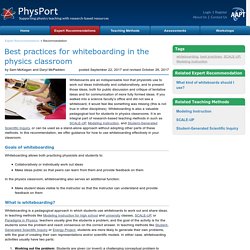
If you walked into a science faculty’s office and did not see a whiteboard, it would feel like something was missing (this is not true in other disciplines). Whiteboarding is also a valuable pedagogical tool for students in physics classrooms. It is an integral part of research-based teaching methods in such as SCALE-UP, Modeling Instruction, and Student-Generated Scientific Inquiry, or can be used as a stand-alone approach without adopting other parts of these methods. In this recommendation, we offer guidance for how to use whiteboarding effectively in your classroom. Goals of whiteboarding.
DIY White Boards - so CHEAP! I was so surprised this week when I asked my colleagues if they knew about how to make super easy and cheap white boards out of white panelboards.
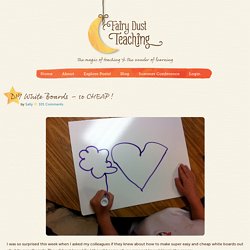
They did not know! So I thought some of you may not know! Here’s the scoop: Go to Lowe’s or Home Depot (lumber store) and locate the White Panelboards (in the paneling section of the store). It is 4 ft by 8ft which cuts into 24 pieces of white board (12 inches by 16 inches). Did you know that they will cut it for you? Just use kleenex or paper towels as easers! Did you enjoy this post? Join the Fairy Dust community and get email updates, tips, tutorials, and instant access to the Fairy Dust Teaching Library - FREE! 15 16 Classroom Strategies. Comprehension Strategies - Teaching Strategies. Fan-N-Pick. So how does Fan-N-Pick work?
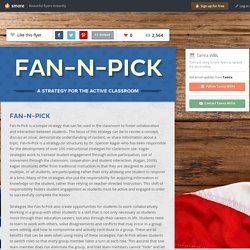
Its actually very simple. You need to start with a set of cards for each group of four students. These cards can be teacher created directly related to content (such as a review activity or questions related to a text or reading) or more general cards such as discussion questions, get-to-know you questions, or higher level thinking questions that can fit multiple content areas. You can also purchase sets of cards through the Kagan website. Students are divided into groups of four, then are numbered off student one through four (or any other creative system you may use). This strategy can be used across any content area. Here is an example of how this strategy could be used in a middle school science classroom: Content topic: Volcanoes Purpose: Review types of volcanoes, volcanic action and effects of volcanic eruptions on Earth's landscapes. Materials: Question cards: each set of cards will have 12 question cards about the content from the volcano unit.
Random Name Selector. 26 Keys to Student Engagement Last year, the Gallup Organization reported that a survey of 500,000 students showed that student engagement plummets every year a child continues in school.
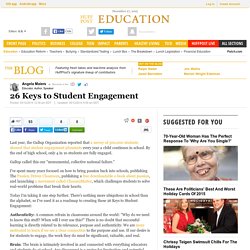
By the end of high school, only 4 in 10 students are fully engaged. Gallup called this our "monumental, collective national failure. " I've spent many years focused on how to bring passion back into schools, publishing The Passion Driven Classroom, publishing a free downloadable e-book about passion, and launching a movement called Choose2Matter, which challenges students to solve real-world problems that break their hearts.
Today I'm taking it one step further. Increase Student Engagement With These Devices. Gallery Walk. Every Student Response Strategies. True implementation of personalized learning in schools requires a shift in the roles of educators and a shift in educator professional learning.
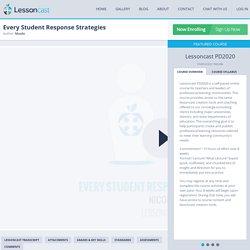
This course examines the evolving role of teachers incorporating personalized learning experiences in the classroom. Taking a close look at what personalized learning is and isn’t, participants create resources to support teacher roles as facilitator, assessor, instructional designer, content curator, coach, and advisor, and family-school collaborator. Lessoncast believes in personalized professional learning. Several modules have assignment options. Participants may choose between the assignments according to which one is more applicable for implementing personalization in their learning environment. While the course opens on July 21 (8:00 am EST), you may register at any time and complete the course activities at your own pace. Increase Student Interaction with "Think-Pair-Shares" and "Circle Chats"
Background When I mentored student teachers I told them, "If I could offer one piece of advice for every teacher — it would be to do think-pair-shares in the class every day.

" The think-pair-share is a very simple, yet effective technique that allows ELL students time to process their thoughts — often in two languages — which takes more time. To understand how this works, imagine you are an ELL student and the teacher has just asked the class a question such as, "Why did the ancient Egyptians create pyramids? " Immediately students around the room shoot up their hands and offer answers. As an ELL student, you are still searching your memory banks to translate the words "ancient" and "pyramids. " At this point you may decide to offer an answer, but the teacher has already moved on and asked two new questions. Turn and Talk. SIOP Activities per component A Newton 2 2013 23fmkwt. Stick Pick. Kagan on Pinterest. Interactive Learning Tool. Instructional Strategies.
Classroom Techniques - Formative Assessment Technique Number One. In previous blogs we’ve outlined how raising hands is not necessarily a good strategy to encourage – Instructional Strategies: Raising Hands in Class and the Outlier Effect.
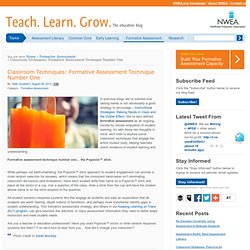
We’ve also defined formative assessment as an ongoing, minute by minute evaluation of student learning. So with these two thoughts in mind, we’ll start to explore some classroom techniques that engage the entire student body, helping teachers solicit evidence of student learning and understanding. Formative assessment technique number one… the Popsicle™ stick. While perhaps not earth-shattering, the Popsicle™ stick approach to student engagement can provide a more random selection for answers, which means that the consistent hand-raiser isn’t dominating classroom discussion (and evaluation).